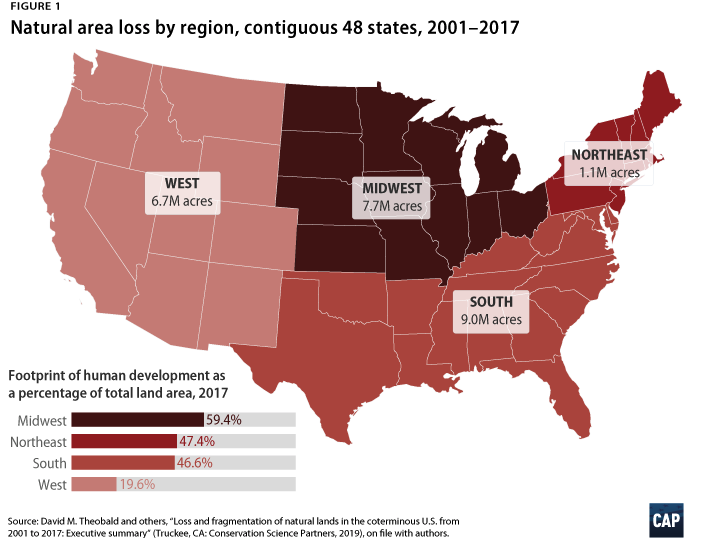
NCEL Blog
30×30 Land and Water Conservation in the States
February 27, 2020
Overview
International momentum has developed around bold actions to conserve our planet’s land and water. Many prominent scientists, including ecologist Edward O. Wilson, have called for the conservation of half of the world’s land and oceans for the long-term health of the planet.
This has sparked a movement to conserve 30% of the world’s land and oceans by 2030. The international community has heavily pursued the 30×30 target with the goal of getting countries to commit to 30% protection at the next Convention on Biological Diversity.
In 2019, two key reports were released which identify the global need for increased land and water conservation efforts:
- The UN Intergovernmental Science-Policy Platform on Biodiversity and Ecosystem Services (IPBES) released the Global Assessment Report on Biodiversity and Ecosystem Services. This report found that three-fourths of land and two-thirds of marine environments have been “significantly altered” by human activity. In addition, they found that one million species of plants and animals are threatened with extinction.
- The International Panel on Climate Change (IPCC) released the Special Report: Climate Change and Land detailing the connection between land and climate change. Check out the NCEL blog on this report to learn more.
There are also serious efforts underway in the U.S. to make progress towards the 30×30 goal. While these international and national efforts are gaining traction, there’s still a long road ahead before actual commitments are made. This leaves an opportunity for states to get out at the forefront of the 30×30 movement. States can pass legislation creating progress and put pressure on the federal government to follow their lead.
30×30 Internationally
The leading international movement advocating for 30×30 is the Campaign for Nature. The campaign is a partnership between the Wyss Campaign for Nature, National Geographic Society, and a growing coalition of more than 100 conservation organizations around the world. In 2010, the Convention on Biological Diversity (CBD) called for the protection of at least 17% of land and 10% of oceans by 2020. So far, about 15% of Earth’s land and 7.9% of its marine areas has been protected. As countries come together this year for the next CBD meeting, the Campaign for Nature is pushing countries to up their 30×30 commitments.
30×30 in the U.S.
The 30×30 movement has also gained traction at the national level in the U.S. The 2020 Conservation in the West Survey found 73% of voters in Western states favor a national 30×30 goal.
Senators Tom Udall (D-NM) and Michael Bennet (D-CO) have introduced Senate Resolution 372, which seeks to establish a national goal of conserving 30% of US land and oceans by 2030. A companion bill was introduced in the House by Representative Deb Haaland (D-NM). A group of 74 NGOs have sent letters to Congress voicing their support for both bills.
In addition, Democratic presidential candidates Joe Biden and Pete Buttigieg have both included the 30×30 concept into their national platforms.
30×30 in the States
There is an opportunity for states to take the lead and push forward the 30×30 movement. They can do so by introducing and passing state-level 30×30 legislation and by supporting the passage of the 30×30 bills in Congress.
South Carolina has been the first state to introduce a state version of 30×30. Introduced by Senator Vincent Sheheen and Representative William Cogswell, S.B.1024/H.B.5125 sets a state goal of protecting 30% of the state’s land and water. The bill focuses on the state waters so it can be replicated in non-coastal states.
To ensure the means to achieve this goal are specific to South Carolina, the bill establishes a Thirty-By-Thirty Interagency Taskforce. The taskforce coordinates with state agencies and tracks progress toward achieving the land and water protection goal. The bill also requires the head of each state agency to develop and implement a plan for how the agency will help achieve the 30×30 goals. Read the South Carolina Bill
Two other states have introduced bills taking steps towards the 30×30 goals:
- California A.B.3030: Requires working with the federal government, local communities, Native American tribes, and private landowners to conserve at least 30% of the land and 30% of the ocean within the state by 2030.
- Hawaii H.B. 2591: Funds stakeholder engagement and outreach as the State Division of Aquatic Resources helps achieve the Governor’s 30×30 marine initiative.
30×30 Across Levels of Government
States passing legislation puts pressure on the federal government to do the same nationally. By implementing 30×30 in states, it will help push the case for establishing national 30×30 goals. States can also support the national efforts for 30×30 by passing concurrent resolutions supporting the federal bills or sending letters directly to Congress as former members of Congress have.
Achieving a global goal of conserving 30 percent of all land and oceans will take action and coordination between all levels of government.
